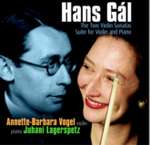|
Back
03/16/2010
Hans Gál: Sonata in B flat minor for violin and piano, Op. 17 (1920) – Suite in G major for violin and piano, Op. 56 (1935) – Sonata in D for violin and piano, posth. (1933)
Annette-Barbara Vogel (violin), Juhani Lagerspetz (piano)
Recorded at St. George’s, Bristol, England (20-22 April 2009) – 61’12
AV2182 – Booklet in English and German

Hans Gál, a famous music scholar at the University of Edinburgh, is perhaps lesser-known as a contemporary Austro-German composer. Indeed, with his reputation being upstaged by his contemporaries such as Schoenberg and Stravinsky, Hans Gál is one of the most underrated composers of the twentieth century. This disc includes the composer’s three early works for violin and piano, all dated in the 1920s and 30s, a period of Gál’s rapid rise to success as a composer.
Being in the period of the Second Viennese School, Hans Gál, an Austrian himself, did not embrace serialism and twelve-tone music. Instead, his style is rooted deeply in the Austro-German tradition from Bach through Beethoven to Brahms. Extended tonality of the early twentieth century rubs shoulder with conventional phraseology and part-writings, bestowing on his music a unique and idiosyncratic sound that can only be found under Gál’s pen. The intricate polyphony in the Rondo of the G major Suite, the Schubertian lyricism of immense beauty in the final movement of the Sonata in D, and the Brahmsian pianistic sonority in the B flat minor Sonata are telling exemplifications of Gál’s crystallization of this glorious tradition through his own musical language. Just from the titles of movements of the G major Suite (Preambulo, Capricio, Aria, and Rondo), one may realize Gál’s homage to the Baroque and Classical musical styles. But it is indeed the tuneful melodies, straightforward formal designs, and sense of simplicity and naïveté that engender the impression of a Classical ‘suite’.
Violinist Annette-Barbara Vogel and pianist Juhani Lagerspetz demonstrate their native understanding to Gál’s musical language by adopting a fluent pace and light-hearted articulation for most of the time. Rarely a note goes by with grandiloquence and artificiality. The two musicians are also very aware of the chamber music element of the works. The violin is never domineering and enchanting dialogues between the two are assertively spoken with hand-in-glove collaboration. My one minor reservation is that Ms. Vogel’s relatively thin and silky tone somehow compromises the introspective and ruminative side of the music. I would perhaps have welcomed a greater feeling of intensity and profundity with more tonal warmth and depth from both players.
The sound is recorded with appropriate spatial sense, not too hollow for a chamber music recording, nor too close as if it were recorded in a small studio. The CD leaflet which contains Ms. Vogel’s own ‘preface’ and her thoughtful interview provides comprehensive information on the biographies of the composer and two performers, as well as the backgrounds of the three pieces. For music aficionados who have indulged in Hans Gál’s music, this recording is definitely the one to include in your collection. For those who have not heard of Hans Gál, you will certainly be enthralled to his music after you listen to it.
Danny Kim-Nam Hui
|